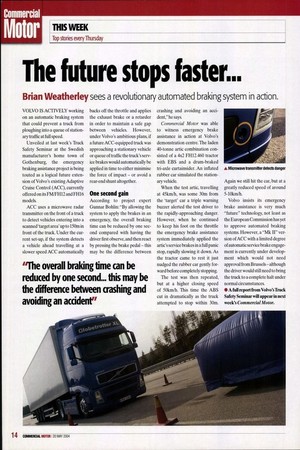The future stops faster...
Page 14

If you've noticed an error in this article please click here to report it so we can fix it.
Brian Weatherley sees a revolutionary automated braking system in action.
VOLVO IS ACTIVELY working on an automatic braking system that could prevent a truck from ploughing into a queue of stationary traffic at full speed.
Unveiled at last week's Truck Safety Seminar at the Swedish manufacturer's home town of Gothenburg, the emergency braking assistance project is being touted as a logical future extension of Volvo's existing Adaptive Cruise Control (ACC), currently offered on its FM/FH12 and FH16 models. ACC uses a microwave radar transmitter on the front of a truck to detect vehicles entering into a scanned 'target area' up to 150m in front of the truck. Under the current set-up, if the system detects a vehicle ahead travelling at a slower speed ACC automatically
backs off the throttle and applies the exhaust brake or a retarder in order to maintain a safe gap between vehicles. However, under Volvo's ambitious plans, if a future ACC-equipped truck was approaching a stationary vehicle or queue of traffic the truck's service brakes would automatically be applied in time to either minimise the force of impact — or avoid a rear-end shunt altogether. One second gain According to project expert Gunnar Bohlin: "By allowing the system to apply the brakes in an emergency, the overall braking time can be reduced by one second compared with having the driver first observe, and then react by pressing the brake pedal — this may be the difference between
crashing and avoiding an accident," he says.
Commercial Motor was able to witness emergency brake assistance in action at Volvo's demonstration centre. The laden 40-tonne artic combination consisted of a 4x2 FH12.460 tractor with EBS and a drum-braked tri-axle curtainsider. An inflated rubber car simulated the stationary vehicle.
When the test attic, travelling at 45km/h, was some 30m from the 'target' car a triple warning buzzer alerted the test driver to the rapidly-approaching danger. However, when he continued to keep his foot on the throttle the emergency brake assistance system immediately applied the attic's service brakes in a full panic stop, rapidly slowing it down. As the tractor came to rest it just nudged the rubber car gently forward before completely stopping.
The test was then repeated, but at a higher closing speed of 50km/h. This time the ABS cut in dramatically as the truck attempted to stop within 30m.
Again we still hit the car, but at a greatly reduced speed of around 5-10km/h.
Volvo insists its emergency brake assistance is very much "future" technology, not least as the European Commission has yet to approve automated braking systems. However, a "Mk II" version of ACC with a limited degree of automatic service brake engagement is currently under development which would not need approval from Brussels — although the driver would still need to bring the truck to a complete halt under normal circumstances.
• A fun report from Volvo's Truck Safety Seminar will appear in next week's Commercial Motor.




























































































































































































